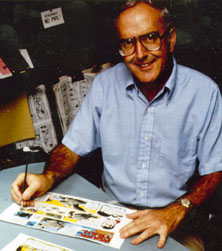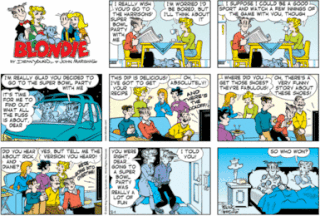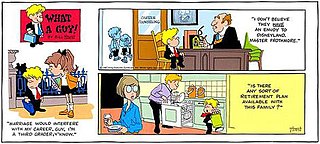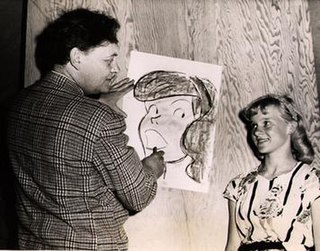
A cartoon is a type of illustration, sometimes animated, typically in a non-realistic or semi-realistic style. The specific meaning has evolved over time, but the modern usage usually refers to either: an image or series of images intended for satire, caricature, or humor; or a motion picture that relies on a sequence of illustrations for its animation. Someone who creates cartoons in the first sense is called a cartoonist, and in the second sense they are usually called an animator.
The National Cartoonists Society (NCS) is an organization of professional cartoonists in the United States. It presents the National Cartoonists Society Awards. The Society was born in 1946 when groups of cartoonists got together to entertain the troops. They enjoyed each other's company and decided to meet on a regular basis.

A cartoonist is a visual artist who specializes in drawing cartoons or comics. Cartoonists include the artists who handle all aspects of the work and those who contribute only part of the production. Cartoonists may work in many formats, such as booklets, comic strips, comic books, editorial cartoons, graphic novels, manuals, gag cartoons, illustrations, storyboards, posters, shirts, books, advertisements, greeting cards, magazines, newspapers, and video game packaging.

Murat Bernard "Chic" Young was an American cartoonist who created the comic strip Blondie. His 1919 William McKinley High School Yearbook cites his nickname as Chicken, source of his familiar pen name and signature. According to King Features Syndicate, Young had a daily readership of 52 million. Stan Drake, who drew Blondie in the 1980s and 1990s, stated that Young "has to go down in history as one of the geniuses of the industry."

They'll Do It Every Time was a single-panel newspaper comic strip, created by Jimmy Hatlo, which had a long run over eight decades, first appearing on February 5, 1929, and continuing until February 3, 2008. The title of the strip became a popular catchphrase.

King Features Syndicate, Inc., is a print syndication company owned by Hearst Communications that distributes about 150 comic strips, newspaper columns, editorial cartoons, puzzles, and games to nearly 5,000 newspapers worldwide. King Features Syndicate is a unit of Hearst Holdings, Inc., which combines the Hearst Corporation's cable-network partnerships, television programming and distribution activities, and syndication companies. King Features' affiliate syndicates are North America Syndicate and Cowles Syndicate. Each week, Reed Brennan Media Associates, a unit of Hearst, edits and distributes more than 200 features for King Features.

The Lockhorns is a United States single-panel cartoon created September 9, 1968 by Bill Hoest and distributed by King Features Syndicate to 500 newspapers in 23 countries. It is continued today by Bunny Hoest and John Reiner.
Bunny Hoest, sometimes labeled The Cartoon Lady, is the writer of several comic strips, including The Lockhorns, Laugh Parade, and Howard Huge, all of which she inherited from her late husband Bill Hoest. She is the co-creator of Bumper Snickers in 1974, Agatha Crumm in 1977, Laugh Parade in 1980, Howard Huge in 1981, What A Guy! in 1986, and Hunny Bunny's Short Tales in 1992.

Laugh Parade was a group of weekly gag cartoons written by Bunny Hoest and drawn by John Reiner. It ran in Parade, a Sunday newspaper magazine supplement.

Grin and Bear It is a former daily comic panel created by George Lichtenstein under the pen name George Lichty. Lichty created Grin and Bear it in 1932 and it ran 83 years until 2015, making it the 10th-longest-running comic strip in American history. Frequent subjects included computers, excessive capitalism and Soviet bureaucracy. Situations in his cartoons often took place in the offices of commissars, or the showrooms of "Belchfire" dealers with enormous cars in the background. His series "Is Party Line, Comrade!" skewered Soviet bureaucrats, always wearing a five-pointed star medal with the label "Hero".

Bill Hoest was an American cartoonist best known as the creator of the gag panel series, The Lockhorns, distributed by King Features Syndicate to 500 newspapers in 23 countries, and Laugh Parade for Parade. He also created other syndicated strips and panels for King Features.

Henry Boltinoff was an American cartoonist who worked for both comic strips and comic books. He was a prolific cartoonist and drew many of the humor and filler strips that appeared in National Periodical comics from the 1940s through the 1960s.
Glenn McCoy is a conservative American cartoonist, whose work includes the comic strip The Duplex and the daily panel he does with his brother Gary entitled The Flying McCoys. McCoy previously produced editorial cartoons until May 2018, when he refocused his career on animations after being discharged from his job of 22 years at the Belleville News-Democrat. All three cartoon features are syndicated by Andrews McMeel Syndication.

John Marshall is an American cartoonist, best known as the artist of the Blondie comic strip since 2005. He works closely with scripter Dean Young, son of the strip's creator, Chic Young.

Jay Malcolm Kennedy was an American editor and writer. The author of The Official Underground and Newave Comix Price Guide, he was a long-time editor at King Features Syndicate, eventually rising to the position of editor-in-chief.

Agatha Crumm is a newspaper comic strip created by the cartoonist Bill Hoest and distributed by King Features Syndicate. The strip ran from October 24, 1977 until 1997. Agatha Crumm was Hoest's third strip, following Bumper Snickers (1974).

What a Guy! is an American comic strip created by Bill Hoest and Bunny Hoest, the team responsible for The Lockhorns and Agatha Crumm. It began in March 1987, just over a year before Hoest's death in 1988.
Rina Piccolo is a Canadian cartoonist, best known for her comic strip Tina's Groove, distributed by King Features Syndicate since 2002. She has been a professional cartoonist for more than two decades and recently gained recognition as an author of short stories. Since 2016, she has assisted Hillary Price on the comic strip Rhymes with Orange.

Harry William Haenigsen was an American illustrator and cartoonist best known for Penny, his comic strip about a teenage girl. He also illustrated for books, magazines and advertising.
Quincy is an American syndicated newspaper comic strip published from July 13, 1970 to October 4, 1986, created and produced by cartoonist Ted Shearer. The series, about an African-American boy being raised by his grandmother in Harlem, was one of the earliest mainstream comic strips to star an African American in the lead role, following Dateline: Danger! (1968-1974) and Luther (1969-1986). Another predecessor, Wee Pals, features an African-American among an ensemble cast of different races and ethnicities.















